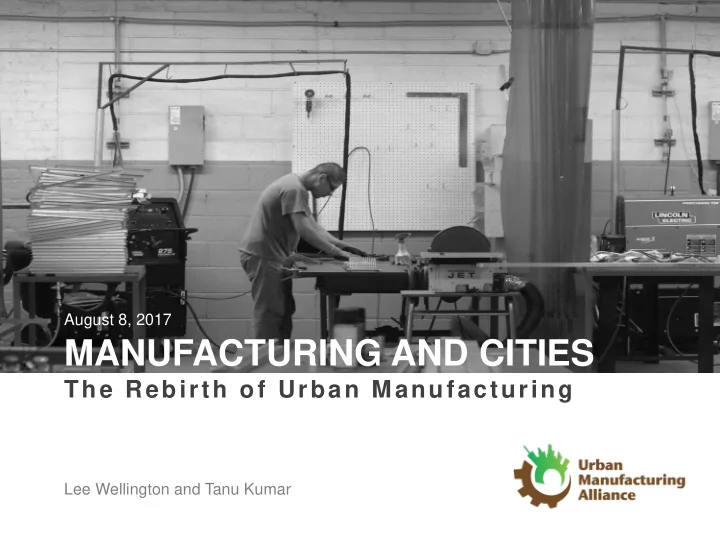

August 8, 2017 MANUFACTURING AND CITIES The Rebirth of Urban Manufacturing Lee Wellington and Tanu Kumar
UMA includes 600 members From 200 cities in 30 states and 5 countries . Working together to strengthen urban manufacturing
Making vs. Manufacturing: Conceptual definition See: The Maker Economy In Action at www.urbanmakereconomy.org Scale: -Employment -Sales volume -Units Business model: -Flexible vs. Fixed -Intent to commercialize
Manufacturing Output Has Grown Source: Federal Reserve Bank/Haver/Marketwatch
Misperception: Manufacturing is declining
Reasons for Job Stabilization: Competitive Advantages Business Strategies Advantages of Cities and Towns • Shorter Supply Chains • Transportation hubs • Local/Custom Products • Strong consumer markets • • Workforce Productivity Dense labor markets • • Advanced Manufacturing Major tech hubs
Rebirth of Urban Manufacturing: Pursuing A High Value Strategy Urban Manufacturing Past Urban Manufacturing Today 7
Living Wage?
Living Wage? Hourly Living Wage (2 Working Adults, 2 Children) Average Hourly Production Wage $25 $20 $15 $10 $5 $0 Sources: Bureau of Labor Statistics, Occupational Employment Statistics, 2014; MIT Living Wage Calculator
Manufacturing Challenges in Cities and Towns • Land Use – High Costs – Aging Infrastructure – Land Use Conflicts • Workforce Development – Skills mismatch – Access to technology • Relationship Management – Cities have vast, complex, hidden networks • Contract manufacturers, consumer markets, government agencies
A national collaborative of non-profit, for-profit and governmental stakeholders working together to grow urban manufacturing , create living wage jobs and catalyze sustainable local economies . Board of Directors: • Adam Friedman (Chair) New York • Kate Sofis (Co-Founder) San Francisco • Matthew Clayson Detroit • Michael Cooper Philadelphia • Elizabeth Demetriou LISC • Steven Doehler Cincinnati • Cecilia Estolano Los Angeles • Eric Strickland Indianapolis 11
UMA Strategy: How We Do It • Strengthening the practice through collaboration in: – Research – Program development – Fundraising • Practitioner-driven Communities of Practice • Highlighting successful projects • Informing public discussion
Local Branding
Consumer Education
Marketing Services Made in NYC strengthens the marketing capacity of manufacturers by leveraging the world-class creativity and expertise of Pratt Institute faculty and students. Creating Developing marketing Using communications assets strategies social media 122 122 15 15 50 50 companies companies companies
Public Education
Interactive Developments
Makerspaces and Contract Manufacturing
Dynamic Zoning Source: Specialty Food Association
Non-Profit Industry Development Advantages: • Mission-driven curation and investment • Strong links to community to foster resident employment • Access to public funding Greenpoint Manufacturing & Design Models: Center, NYC • Brooklyn Navy Yard - NYC • Brick City – St. Louis • Circle City – Indianapolis • Hundred Hooper – San Francisco • Dorchester Bay EDC - Boston PlaceMade, Hundred Hooper, SF
The Equitable Innovation Economies Initiative (EIE) helps cities pursue inclusive growth strategies in their innovation and manufacturing sectors to advance more equitable outcomes.
MANUFACTURING: INDUSTRY OF OPPORTUNITY? People of color are under-represented in higher paying occupations within manufacturing Demographics and median wages fro select manufacturing occupations, U.S. 2010 Source: American Community Survey 2010,5 year estimates
FOUR PRINCIPLES FOR AN EQUITY-DRIVEN GROWTH MODEL: 1. Choose strategies that promote inclusion and growth simultaneously 2. Target programs and investments to the people and places most often left behind 3. Assess equity impacts at every stage of the process 4. Ensure meaningful community participation, voice and leadership
EIE PILOT CITIES (2014-17)
EIE APPROACH PILOT CITIES COMMUNITY OF PRACTICE COLLABORATIVE FOCUS • • Establish equity objectives for Frequent group and one-on- selected projects one discussions to share updates and provide feedback • Identify groups that will be • most impacted by pursuing In-person meetings and work these objectives sessions tied to UMA events in Philadelphia and Los Angeles • Integrate new perspectives and • partners into program design Technical assistance and coordination from Pratt Center • Realign and refine strategies to and PolicyLink achieve more equitable • outcomes Dissemination of process and learnings with a broader group • Identify equity indicators to of UMA cities measure impact
SELECT EQUITY INDICATORS
Recommend
More recommend